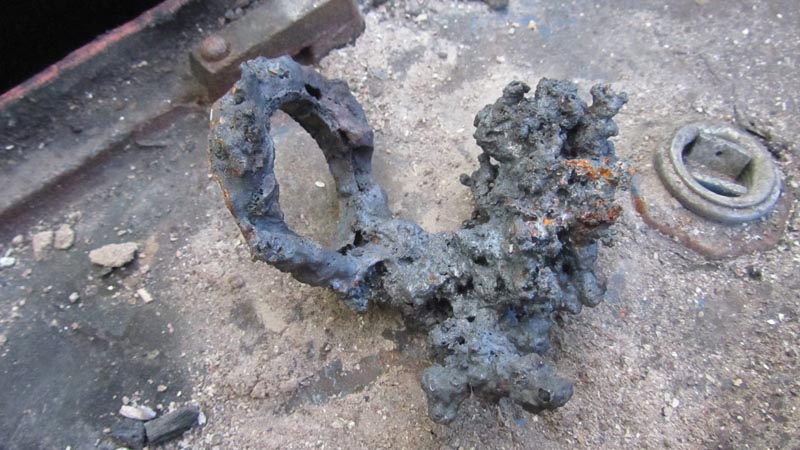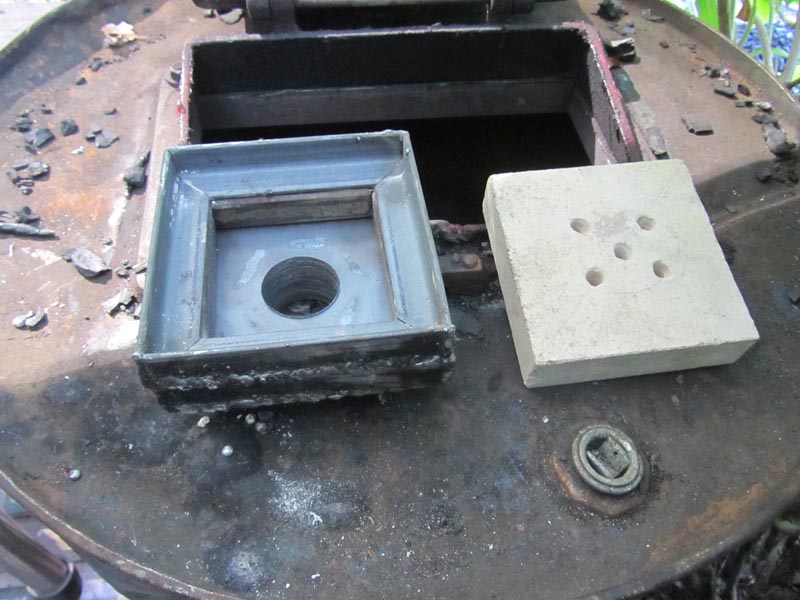I have been debugging my updraft gasifier the past few months. I am wondering if it is time to go downdraft. Here’s the chronology of what leads me to this.
A few months ago during the southern hemisphere summer, the gasifier was putting out good gas. For an air nozzle, I was using a horizontal steel pipe with a cap that had several 1/4” holes drilled in it.
On one run, I got the generator running well and kept an eye on it for the first 10 or 15 minutes. Stupidly, I walked away for about an hour and came back to this melted mess.
I then devised a ceramic nozzle. I welded a holder for a brick that had holes drilled through it. The holder was at the bottom of the gasifier.
I got good gas again, but slag was building up on the brick.
I then cut a brick in half to make a slit opening. It was easier than drilling holes. I added a water drip in the form of an ultrasonic mister. I figured it was an easy way to control the amount of water and could be powered by the generator. That way, when the generator shut down, so would the water input. I did a run for about an hour. I didn’t have a buck step up converter to control the mister yet, so I ran it at full voltage I had some water condensing out in the heat exchanger, so I was surprised that when I removed the nozzle for inspection, it had thick layers of slag.
Fast forward a couple of months. At this point I came to the conclusion that the only way to avoid slag on the nozzle was to have it pointing downwards. So I built one that would fit in the bung hole of the gasifier barrel and protected it from heat with a water jacket. The nozzle had a single 7/8” hole – the diameter of the inner air tube.
I ran the new nozzle for an hour with water mist. The nozzle had no damage, but the quality of gas was poor. There was a bunch of water condensing out at the heat exchanger and final filter. At least the nozzle had no heat damage at all.
I then narrowed the opening to a single 7/16” hole. I still got poor quality gas – there is way too much water in it. I think I flooded the charcoal load when I ran with the mister. After a run I left the loading door open to let the heat bake off water in the charcoal. Then I did another run and the gas was good. Good flare and good generator running. However, after adding in more charcoal, I’m back to condensing water out at the heat exchanger and the gas quality is down.
I think the charcoal I made several months ago has absorbed moisture from the atmosphere. Summer here is extremely dry, but fall and winter is extremely wet and humid. Unless I get a number of barrels I can hermetically seal, the updraft style of gasifier won’t work.
So I am looking for a good downdraft design where the water might be converted to H2. Also, I always liked the ability to clean the gasifier without completely emptying it like the updraft.
I am thinking that a hearth made with ceramic bricks and a water cooled nozzle pointing downwards like what I currently have may be a viable design.
I wonder what size to make the hearth. When I run my 3.5kw generator, I develop what appears to be a basketball sized mass of burning charcoal. This surprises me, as I expected something more akin to the size of a hearth in a downdraft.
So, can anyone suggest a design they can point me towards? Thanks!












